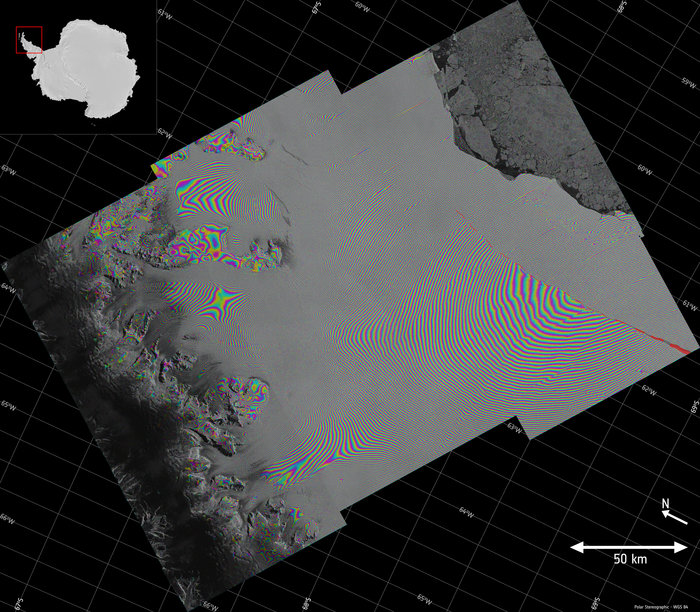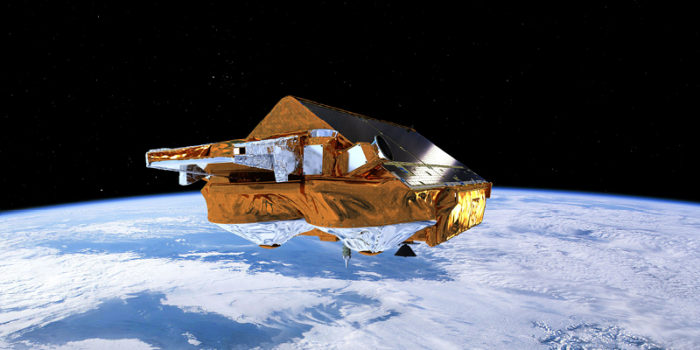Media interest mounts over Antarctica’s imminent iceberg calving

The imminent* calving of a 6,000 square-kilometre chunk of Antarctica’s Larsen C ice shelf has caused a buzz of interest in the global media, with University of Leeds’ Dr Anna Hogg widely quoted.
The story of the “giant ‘white wanderer’ poised to break free” was covered by Jonathan Amos for the BBC (5 July), with news channels CNN and Fox News also picking up the story. The ‘berg – variously described as “a quarter of the area of Wales” (BBC) or “the size of Delaware” to US audiences – is due to shear off soon, with only 5km more to go in the 200km-long crack in the ice shelf. When it calves from the Antarctic Peninsula’s east coast, it will be one of the largest icebergs of all time.
The crack’s progress is being tracked by the Copernicus Sentinel-1 satellite while an Earth Explorer satellite from the European Space Agency’s CryoSat mission allows calculations to be made about the eventual iceberg’s height and depth below water (which could be as much as 210m). In total, the iceberg could contain 1155 cubic km of ice.
Anna Hogg, ESA Living Planet Fellow at the School of Earth and Environment, said they were not yet sure what will happen with the Larsen C iceberg. “It could, in fact, even calve in pieces or break up shortly after. Whole or in pieces, ocean currents could drag it north, even as far as the Falkland Islands. If so it could pose a hazard for ships in Drake Passage.
“What is certain, though, is that we shall continue to use CryoSat to keep a check on its progress.”
Because Antarctica is often covered by thick cloud, visual tracking of the ‘berg’s progress is difficult and intermittent, which makes the satellites’ role vital.
“What the current Larsen situation has highlighted is that we’re now able to monitor the situation with a frequency we’ve never had before,” Dr Hogg told the BBC. “We can get pictures from the two Sentinel-1 satellites in about half an hour of them being acquired. The satellites we have now are revolutionising our study of the polar regions.”

European Space Agency CryoSat-2
The story is also carried by the Washington Post, International Business Times, Huffington Post, Daily Mail, Yahoo News, Business Insider, BT.com, The Weather Channel (USA) and other publications. The Mail Online also ran an update reporting that rifts have been identified within 3 miles of the ice edge and that “multiple icebergs” are now ready to break off.
Iceberg calving is a natural phenomenon and whether climate change has played a part in the formation of the crack is debated in the coverage. The ice shelf is in the north-west part of the Weddell Sea in Western Antarctica, where evidence of melting is well documented. Eastern Antarctica is, however, gaining mass, although the gains are insufficient to compensate for the substantial losses on the west coast. In an article on 6 July headed “What to believe in Antarctica’s great ice debate” Scientific American reports that recent studies using satellites from Esa and NASA suggest this may be due to an upward tilt in the land; other scientists dispute this and ascribe it to additional snowfall.
Andy Shepherd, Professor of Earth Observation at the University of Leeds, who is working on a review that will reconcile findings from the many techniques used to measure the ice mass balance, is quoted in the article saying that controversy is part of the scientific process.
“Everybody has a difference of opinion, and if they didn’t—if everybody believed what had gone before—we wouldn’t move forward.”
Featured image: Larsen C crack interferogram (A. Hogg/CPOM/Priestley Centre, CC BY-SA 3.0 IGO)
* Update 12.07.17: the iceberg has now calved (see BBC, Business Insider, The Independent, The Telegraph). Dr Anna Hogg and Prof Andy Shepherd are also quoted in a new story in The Guardian.
